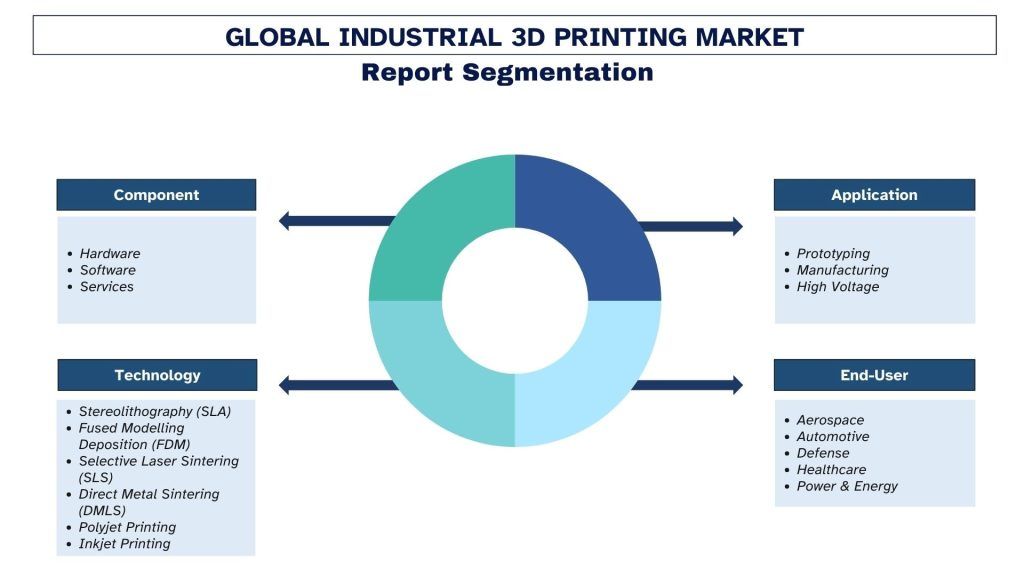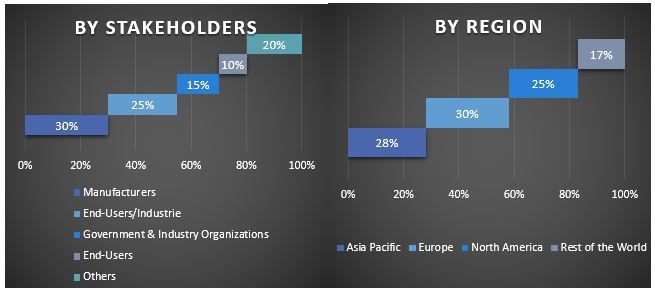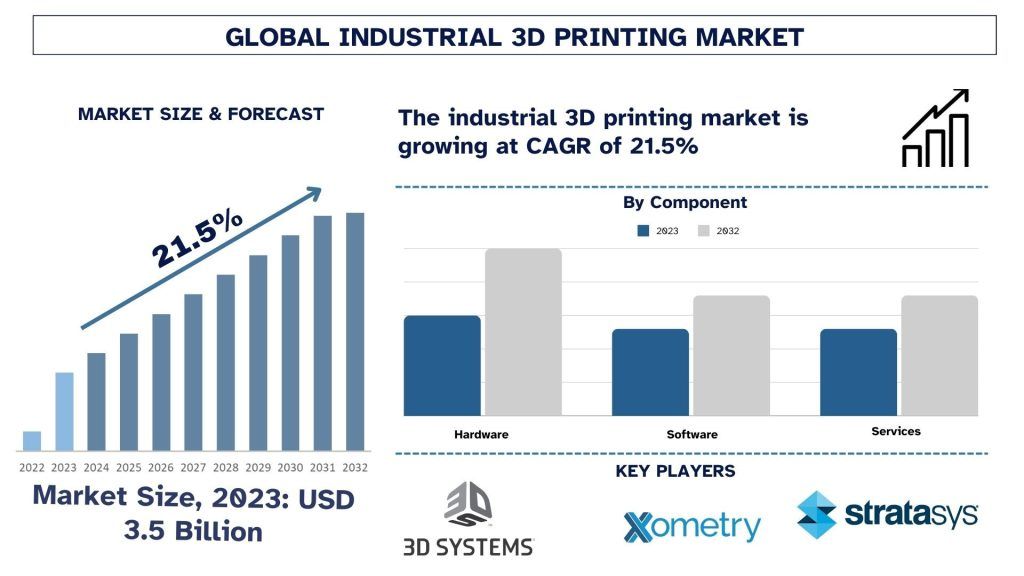- Home
- About Us
- Industry
- Services
- Reading
- Contact Us
Industrial 3D Printing Market: Current Analysis and Forecast (2024-2032)
Emphasis on Component (Hardware, Software and Services); Application (Prototyping, Manufacturing and High Voltage); Technology (Stereolithography (SLA), Fused Modelling Deposition (FDM), Selective Laser Sintering (SLS), Direct Metal Sintering (DMLS), Polyjet Printing, Inkjet Printing); End User (Aerospace, Automotive, Defense, Healthcare, Power & Energy); and Region/Country
Industrial 3D Printing Market Size & Forecast
The Industrial 3D Printing market was valued at approximately USD 3.5 Billion in 2023 and is expected to grow at a robust CAGR of 21.5% during the forecast period (2024-2032) owing to the demand for customization and increasing industrial requirements.
Industrial 3D Printing Market Analysis
Industrial 3D Printing—also known as Additive manufacturing is defined as an advanced digital manufacturing process that allows a physical product to be produced from a CAD file. Owing to industrial 3D printing techniques growing popular, better technology advancement, and increasing industrial requirements, the industrial 3D printing market is expected to grow. Manufacturing firms will spend more because it eliminates the costs of labor and can create products within nations, but, it needs capital input to use the 3D printing technology. The market is a very busy market with so many international and other local market players. The market players are adopting both organic and inorganic ways to sustain competitive advantage. For example, in November 2022, 3D Systems revealed that it has teamed with WeMatter to increase the use of 3D printing of metal and polymer material. Likewise in November 2022, Stratasys Ltd. invested in axial3D to help patient-specific 3D printing solutions for hospitals and medical device manufacturers become mainstream in the healthcare industry.
Although 3D printing is still a small industry, trending growths last year, especially in industrial fields include.

Industrial 3D Printing Market Trends
This section discusses the key market trends influencing the Industrial 3D Printing segments as identified by our research experts.
Hardware Segment Transforming Industry
Hardware was arguably the largest segment in the industry and the growth is expected to be even more dramatic throughout the projected period. The hardware is supported by the growing trend of the increase in industrial needs and technological advancement all over the world. The overall growth of the hardware market is generally attributed to several factors such as early and fast industrialization, increased consumer electronics usage, enhanced civil structures, faster urbanization, and relatively less expensive labor.
North America to hold a significant share of the market
The demand for Industrial 3D Printing in the North American market is mainly attributed to the high demand for future technologies in the Aerospace, Automotive, and medical sectors including others. It has been noted that firms in these sectors are applying 3D printing to enhance the accuracy, and speed of making products, and personalize merchandise by manufacturing them in batches, and to minimize material usage. Further, ROK & CJK enjoys more investment in Research & Development and government policies for innovation in digital manufacturing. The existence of superior quality materials and constantly improving 3D printing technology contribute to the growth of the technology across North America.

Industrial 3D Printing Industry Overview
Industrial 3D Printing is competitive, with several global and international market players. The key players are adopting different growth strategies to enhance their market presence, such as partnerships, agreements, collaborations, new product launches, geographical expansions, and mergers and acquisitions. Some of the major players operating in the market are 3D Systems Corp, Xometry Inc., Stratasys Ltd., Proto Labs Inc., Velo3D Inc., Desktop Metal Inc., Materialise NV, Nano Dimension Ltd – ADR, Markforged Holding Corp., Shapeways Holdings Inc. Several M&As along with partnerships have been undertaken by these players to facilitate customers with hi-tech and innovative products/technologies.
Industrial 3D Printing Market Report Coverage

Reasons to buy this report:
- The study includes market sizing and forecasting analysis validated by authenticated key industry experts.
- The report presents a quick review of overall industry performance at one glance.
- The report covers an in-depth analysis of prominent industry peers with a primary focus on key business financials, product portfolios, expansion strategies, and recent developments.
- Detailed examination of drivers, restraints, key trends, and opportunities prevailing in the industry.
- The study comprehensively covers the market across different segments.
- Deep dive regional level analysis of the industry.
Customization Options:
The Global Industrial 3D Printing can further be customized as per the requirement or any other market segment. Besides this, UMI understands that you may have your own business needs; hence, feel free to connect with us to get a report that completely suits your requirements.
Table of Content
Research Methodology for the Industrial 3D Printing Market Analysis (2022-2032)
Analyzing the historical market, estimating the current market, and forecasting the future market of the global Industrial 3D Printing market were the three major steps undertaken to create and analyze the adoption of Industrial 3D Printing in major regions globally. Exhaustive secondary research was conducted to collect the historical market numbers and estimate the current market size. Secondly, numerous findings and assumptions were taken into consideration to validate these insights. Moreover, exhaustive primary interviews were also conducted, with industry experts across the value chain of the global Industrial 3D Printing market. Post assumption and validation of market numbers through primary interviews, we employed a top-down/bottom-up approach to forecasting the complete market size. Thereafter, market breakdown and data triangulation methods were adopted to estimate and analyze the market size of segments and sub-segments of the industry. Detailed methodology is explained below:
Analysis of Historical Market Size
Step 1: In-Depth Study of Secondary Sources:
A detailed secondary study was conducted to obtain the historical market size of the Industrial 3D Printing market through company internal sources such as annual reports & financial statements, performance presentations, press releases, etc., and external sources including journals, news & articles, government publications, competitor publications, sector reports, third-party database, and other credible publications.
Step 2: Market Segmentation:
After obtaining the historical market size of Industrial 3D Printing, we conducted a detailed secondary analysis to gather historical market insights and share for different segments & sub-segments for major regions. Major segments are included in the report, such as component, application, technology, end-users, and region. Further country-level analyses were conducted to evaluate the overall adoption of testing models in that region.
Step 3: Factor Analysis:
After acquiring the historical market size of different segments and sub-segments, we conducted a detailed factor analysis to estimate the current market size of the Industrial 3D Printing market. Further, we conducted factor analysis using dependent and independent variables such as component, application, technology, end-users, and Industrial 3D Printing regions. A thorough analysis was conducted of demand and supply-side scenarios considering top partnerships, mergers and acquisitions, business expansion, and product launches in the Industrial 3D Printing market sector across the globe.
Current Market Size Estimate & Forecast
Current Market Sizing: Based on actionable insights from the above three steps, we arrived at the current market size, key players in the global Industrial 3D Printing market, and market shares of the segments. All the required percentage shares split and market breakdowns were determined using the above-mentioned secondary approach and were verified through primary interviews.
Estimation & Forecasting: For market estimation and forecast, weights were assigned to different factors including drivers & trends, restraints, and opportunities available for the stakeholders. After analyzing these factors, relevant forecasting techniques i.e., the top-down/bottom-up approach were applied to arrive at the market forecast for 2032 for different segments and sub-segments across the major markets globally. The research methodology adopted to estimate the market size encompasses:
The industry’s market size, in terms of revenue (USD) and the adoption rate of Industrial 3D Printing across the major markets domestically
All percentage shares, splits, and breakdowns of market segments and sub-segments
Key players in the global Industrial 3D Printing in terms of products offered. Also, the growth strategies adopted by these players to compete in the fast-growing market
Market Size and Share Validation
Primary Research: In-depth interviews were conducted with the Key Opinion Leaders (KOLs), including Top Level Executives (CXO/VPs, Sales Head, Marketing Head, Operational Head, Regional Head, Country Head, etc.) across major regions. Primary research findings were then summarized, and statistical analysis was performed to prove the stated hypothesis. Inputs from primary research were consolidated with secondary findings, hence turning information into actionable insights.
Split of Primary Participants in Different Regions

Market Engineering
The data triangulation technique was employed to complete the overall market estimation and to arrive at precise statistical numbers for each segment and sub-segment of the global Industrial 3D Printing. Data was split into several segments and sub-segments after studying various parameters and trends in the component, application, technology, end-users, and regions of the global Industrial 3D Printing market.
The main objective of the Global Industrial 3D Printing Market Study
The current & future market trends of global Industrial 3D Printing were pinpointed in the study. Investors can gain strategic insights to base their discretion for investments on the qualitative and quantitative analysis performed in the study. Current and future market trends determined the overall attractiveness of the market at a regional level, providing a platform for the industrial participant to exploit the untapped market to benefit from a first-mover advantage. Other quantitative goals of the studies include:
- Analyze the current and forecast market size of the Industrial 3D Printing market in terms of value (USD). Also, analyze the current and forecast market size of different segments and sub-segments.
- Segments in the study include areas of component, application, technology, end-users, and regions.
- Define and analyze the regulatory framework for the Industrial 3D Printing
- Analyze the value chain involved with the presence of various intermediaries, along with analyzing customer and competitor behaviors of the industry.
- Analyze the current and forecast market size of the Industrial 3D Printing market for the major regions.
- Major countries of regions studied in the report include Asia Pacific, Europe, North America, and the Rest of the World
- Company profiles of the Industrial 3D Printing market and the growth strategies adopted by the market players to sustain in the fast-growing market.
- Deep dive regional level analysis of the industry
Frequently Asked Questions FAQs
Q1: What is the global Industrial 3D Printing's current size and growth potential?
Q2: What are the driving factors for the growth of global Industrial 3D Printing?
Q3: Which segment has the largest share of the global Industrial 3D Printing by component?
Q4: What are the emerging technologies and trends in global Industrial 3D Printing?
Q5: Which region will dominate global Industrial 3D Printing?
Related Reports
Customers who bought this item also bought











